Technology had made our life easier in comparison to what it was, it takes a second to wipe all that away and once again remind us that we still at the mercy of nature on earth. These events whenever occurs ruin almost everything, it absorbs the place where they occur as if it wasn’t there ever. These powerful events sometimes result in the dramatic physical modifications to the Earth. They also cause suffering and death.
These disasters can occur any time; however we have advanced technique that recognizes if there is any sign of such events to occur and we can save our lives but not our homes and place. We cannot stop such events from occurring but can only guard against them.
Up till now we have witnessed lot many disasters hitting our planet:
a) Landslide
b) Avalanche
c) Drought
d) Wildfire
e) Floods
f) Tsunami
g) Volcanic eruptions
h) Tornado
i) Earthquake
j) Hurricane
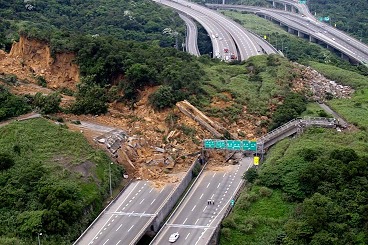
1) Landslides:
It is a disaster that includes tress, rocks, houses and anything else that may happen to slide or swept up.
Reason:
Landslide is caused when stability of slope alters, that it becomes stable to unstable condition, this un-stability arises due to number of factors as listed below:
a) Natural factors:
i) Groundwater pressure acting to destabilize the slope.
ii) Loss or absence of the vertical vegetative structure, soil nutrients, and soil structure (example: after a wildfire)
iii) Erosion of the toe of a slope by rivers or the ocean waves
iv) Weakening of the slope through the saturation by snow melt, glaciers melting, or the heavy rains
v) Earthquakes adding loads to barely stable slope
b) Various human activities like:
i) Deforestation, cultivation and construction that destabilize already delicate slopes.
ii) Vibrations from the machinery or the traffic.
iv) Blasting.
v) Construction, agricultural or the forestry activities (logging) which will modify the amount of water that infiltrates the soil.
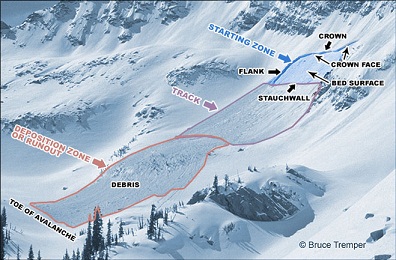
2) Avalanche:
It includes the slide of large snow or rock mass down the mountain, caused when the build up of material is released down the slope, it is one of the most of the dangers encountered within the mountains during winter. When the avalanches move down the slope they may entrain the snow from the snowpack and become large in size. The snow can also combine along with the air and form the powder cloud. Avalanche along with the powder cloud is known as the powder snow avalanche.
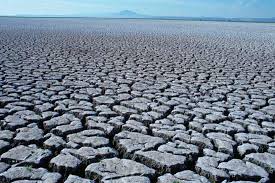
3) Drought:
It occurs when a region suffers a severe deficiency of water for a prolonged period of time. Generally, this takes place whenever a region receives constantly below average rainfall. Drought can have the substantial impact over the ecosystem and agriculture of affected region. Although the droughts can persist for many years, even for a short, intense drought may cause efficient damage and spoil the local economy.
Causes of drought:
a) Rainfall caused due to the amount and dew point of water vapour carried by regional atmosphere, combined with upward forcing of the air mass consisting of water vapour. If all these combined factors do not support the precipitation volumes sufficient to reach the surface, result is a drought.
b) High level of reflected sunlight, and above average prevalence of high pressure systems, winds carrying continental, in spite of oceanic air masses (i.e. decreased water content), and ridges of the high pressure areas from behaviors that avoid developing of thunderstorm activity or rainfall over one certain region.
Human activity:
i) Over farming,
ii) Excessive irrigation,
iii) Deforestation, and
iv) Erosion adversely impacting the ability of the land in order to capture and hold the water.
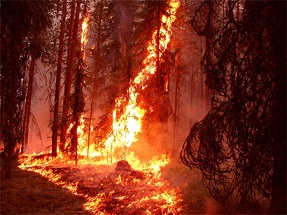
5) Wild Fire:
Wild fire includes uncontrolled fire burning in wild areas. Its causes involve factors such as lightning, arson, human carelessness, volcano eruption, and pyroclastic cloud from the active volcano. This can be a threat to those residing in the rural areas and also to the wildlife.
Thousands of coal seam fires that are burning around the world, such as those in the Centralia, Burning Mountain, and various coal-sustained fires.
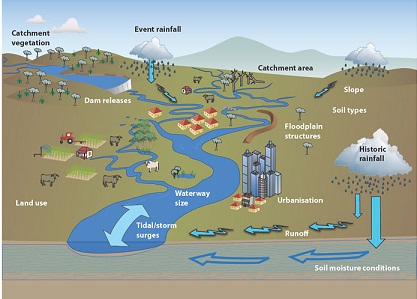
6) Flood:
Flood refers to an overflow of an expanse of water which submerges the land. It is because of the volume of water within a body of water, like a river or lake, exceeding the total capacity of body, and as the result some of the water flows outside the normal perimeter of the body. It may also takes place within the rivers, when strength of the river becomes so high it flows right out of the river channel generally at the corners or meanders.
Causes:
a) Due to excessive rainfall some places over lodged with water creating conditions of floods.
b) Riverine:
Sometimes rise in the level of water within the river may result in flood condition. This rise in water may be because of large amount of rainfall, rapid snow melt, monsoons, or tropical cyclones
River flows may give rise to the floods levels at different rates, from few minutes to several weeks, depending upon the kind of river and the source of the increased flow. Localised flooding may be caused or exacerbated due to the drainage obstructions like ice, landslides, or debris.
6) Tsunami:
Tsunami is defined as a series of waves generated when a body of water, like an ocean, is displaced rapidly. Mass movements, earthquakes, above or below the water, volcanic eruptions and other underwater explosions, landslides, large meteorite impacts comet impacts and testing along with nuclear weapons at sea all have the potential to produce a tsunami.
Tsunami occurs when the sea floor suddenly deforms and displaces vertically the overlying water. Tectonic earthquakes are the kind of earthquake that linked with crustal deformation of Earth; when these earthquakes occurs under the sea, water above the deformed area gets displaced from its equilibrium position.
More precisely, tsunami can be produced whenever the thrust faults associated with the convergent or destructive plate boundaries move suddenly, causing the water displacement, owing to vertical component of movement involved. Movement on the normal faults will also cause displacement of seabed, however size of the largest of such events is normally too small in order to provide rise to the tsunami.